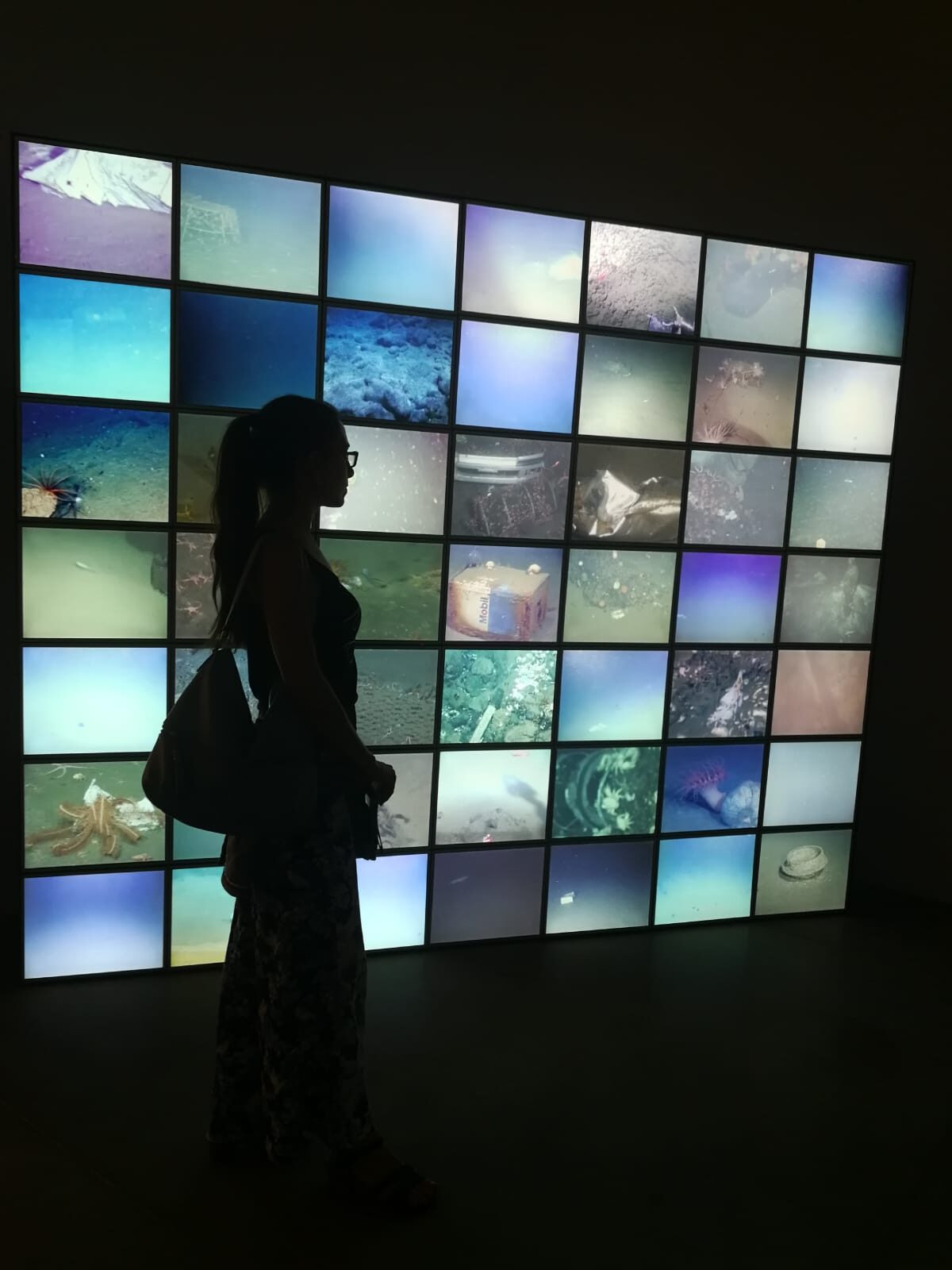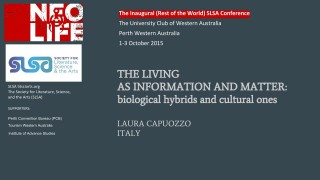for the slides with all the images mentioned in the paper click here —–> BIOLOGICAL HYBRIDS AND CULTURAL ONES by LAURA CAPUOZZO
THE LIVING AS INFORMATION AND MATTER:
BIOLOGICAL HYBRIDS AND CULTURAL ONES
Laura Capuozzo
As Bernard Andrieu says, hybrids exist, they are among, with and in us.
Since the biological body is repaired, dissected and implanted, robots and bionic experiments have opened to a different view on the nature of life.
The creation of “Neolife” deals with an interdisciplinary methodology which generates contamination not only between disciplines , from science, to engineering and art, but also between different cultures.
So, meanwhile the fusion of experience and knowledge on a global scale corresponds to a large transformation of each cultural part involved, the collaboration of different cultural workers in recreating Life also deals with their sharing of the perception of hybridity.
In this complex scenario, the issues that Neolife focuses are truly a lot, but in my speech, as an artistic and cultural researcher, I would like to draw your attention on the different approaches to life and living and the related issues emerging from contemporary bio-art practices, consequently to the achievements of regenerative biology.
As you know, some of the pioneers of synthetic biology, “hope to make biology something that can be designed and constructed in the same way electronic components are pieced together to produce working computers” (What is Synthetic Aesthetics?), building synthetic organisms capable of accomplishing specified goals. And, from this perspective – I will talk about soon – synthetic biology would represent the perfect synthesis between computer science and biological sciences.
Synthetic Aesthetics, a project run by the University of Edinburgh and Stanford University, is bringing together synthetic biologists, designers, artists and social scientists to explore the collaborations among them. They hopes these interactions “will contribute to ongoing work in both communities, developing new spaces for practice, cooperation and debate” (What is Synthetic Aesthetics?).
I believe that hybridization, meaning confrontation and appropriation of the “new”, is a constant path of Art.
But designing nature, as you know, is not linear: when the living world becomes a product of design and manufacturing choices, rather than evolutionary pressures, the question becomes: “what does it really mean to design the nature, and what is the new role of the artist in this process? Could synthetic biology – and the questions it raises about the synthetic construction of life – benefit from such interactions?
So the term “Living design”, used by Luis Bec to describe these activities on the surface and within living subject, suggests that this “artificialisation of the living”, also blinds the interdisciplinarity of the artistic practices to their ethical foundations, raising bioethical issues.
In a culturally hybrid landscape, speaking about the boundaries of the living in relation to the technological achievements, also means to reconsider both our biological identity and the contemporary artistic productions as a fluxus.
—–
In 2010, when I started to write my thesis on the relationship between new media arts and biotech arts (Quando l’Arte ri-crea la vita. Ibridazioni tra Informatica e Biologia.Specialist Degree Thesis. Relator Prof. Tommaso Tozzi), I took note that contemporary art criticism discerned them according to their different approach to the life and the living, defined dry, in the first case and wet, in the second. Consequently, artworks by Sommerer and Mignonneau, Edoardo Kac, Marta de Menezes, the Tissue Culture & Art project and others have been categorized, depending on the tools they have used, even though many of those were on the threshold between the natural world and the artificial one.
Combining biological components with computer ones they underline – pursuing the utopia of the re-creation of Life – a conception of the living as a “floating hybrid”.
In other words, at the same time, the living system was considered “information and matter” and artists “formatted and rewrote it”, in binary code as in test tube.
Some of those practices were showing us that contemporary art was becoming trans-medial.
Kac himself, from 1985, using digital media and not – through his research and projects like A-positive or The Eighty Day – anticipated the convergence between the digital and the organic.
The BioBot, an hybrid machines that incorporate a biological active substance into his body, was the symbol of the coexistence of living matter and information technology.
So, in exploring new forms of interface between various forms of living (human, plants, animals), and between the living and the robots to create hybrids, he also pointed out a reflection on the condition of the human body in a new context in which biology meets computer science and robotics, suggesting that hybridization were penetrating the sacred boundaries of the flesh, with profound cultural and philosophical implications.
So, I wrote down that some artworks – like Kac’s The Eighty Day or Sommerer and Mignonneau’ Interactive Plant Growing – even if they were related to the creation of artificial life, have connected the “digital” bios to the “organic” one, and for this reason they should be considered a bridge between the computer visualization of biological processes and the direct manipulation of the living being.
Moving along the boundary between the biology and the computer science – they have been a fertile ground from which the biotech art has been inspired and could divert, leaving the virtual dimension of the simulation, in order to adopt a re-materialized one, which tends to corporeality.
Then I located Biotech Art practices in the intersection between the inorganic and the organic realm, showing the interferences among new media arts and bio arts.
I realized, therefore, that intersection was tracing a new direction for the art world, anticipating their total hybridization in current artistic practices related to synthetic biology.
Because of this hybridization among theories and technologies, I titled these new art practices infoBIOtic Art.
Later, in 2012, I referred back to the speech of Franco Torriani on hybridization in contemporary art at the Seminar of the PAV – which is an Experimental Centre for Contemporary Art in Turin, dealing with the ongoing dialogue between art and nature, biotechnology and ecology.
In that occasion I put down some thoughts on the concept of hybrid and surroundings, trends and some cases.
Among these I mentioned the Korean artist Jinsil Seo who creates, with her teacher Diane Gromala, a Meatbook interbreeding the skin of a pork with a technological equipment ruled by a computer, making the viewer literally able to feel the flesh, which was no more used as an interface between reality and virtuality, but as an agent.
The Meatbook was, in fact, presenting the symbiosis of the mechanical and the organic as it concurrently juxtaposes the conflicting materiality of these media.
So I underlined that, in experimenting the hybridization between the technology and the flesh, she was truly interbreeding the wet and the dry (Roy Ascott coined the term moist media in Art, Technology, Consciousness: Mind@large).
The concept of hybrid was beginning to move away to from the notion of “mechanic” and the technique was no longer considered by the bio-artists as a ‘prosthesis’, making us hope, therefore, for a fruitful dialogue between anthroposphere and technosphere, which could lead to consider technology not only as a partner that can enhance our knowledge of the world, through the extension of our senses, but as ‘input’ and a testing ground for new perceptions.
LIVING DESIGN and BIOETHICS
As you know, interesting developments in the field of 3D printing made it possible to combine more materials in the same object, foreseeing and planning in advance the desired behavior that material should have for a given product and function.
Daniel Widrig realizes, in 2014, the Degenerated Chair, merging nature and technology into one object. Thanks to 3d printing he produces a biological material obtained with sugar, gypsum and Japanese rice wine. A striking example of the contemporary materiality: a hybrid, organic, open-source material, printed in a form digitally obtained and even aesthetically digital.
From this scenario, 3D printing reinforce the convergence of the digital and biological processes since nature becomes a printable material: we can build it, in a timely and efficient way, according to specific needs.
The project Edible Growth by the food designer Chloé Rutzerveld blends food, gardening, and 3d printing. It consists of forms 3d printed with seeds, spores and yeast that will begin to grow after a few days and produce vegetables and mushrooms.
At present it is only a conceptual artwork, but the open source availability of the living matter raises several points for reflection concerning the self-production of these Neolives as another aspect of the material culture in the digital age.
In other words, if we can “program” the structure of the living at any time and according to the logic of increased productivity, there is no longer only chance- paraphrasing Foucault – to “keep alive or drive back into death”.
From the idea that science could produce “more and better” everything that man needed, starts the interpretation of the concept of technology as a factor of industrial growth and the definition of a “materialistic concept” of progress argued by Van Rensselaer Potter – the oncologist who introduced the term bioethics – but emerged also the urgency of a not separated biological knowledge and human values and the need of a “long-term wisdom” in approaching to the technological achievements .
As Jeremy Rifkin points out, the explanation of the complexity of an organism does not reside only in the information contained in its genes, but is to be found in the optimization of the relationships between them. (Human life as intellectual property by Jeremy Rifkin )
In today’s biopolitics scenario, comes forward the need for what Kant defined an ”ethics of the form“, that is the introduction, in the human technology, of an optional component, a way of “production through freedom“.
In connecting technique (or techne) to the rational reflection, as the ability to reflect on the nature, for Kant “to design” meant to anticipate the consequences of the productive process.
At last, in 1962, Van Rensselaer Potter in his book The Science of Survival, in supporting the need for an ethics of the living, said that it should have an interdisciplinary character.
So, in sharing the experiences of making new hybrid living systems, with scientists, engineers, and other cultural workers, artists also share the responsibility in the creation of Neolife, they share, quoting Fusser, the same “principle of integrity“.
“The great scientists and great artists are not only subjective and pure but also objective and responsible inventors”, Fuller said. He felt that artists had a unique position because of their comprehensive training which frequently gave the artists a broader viewpoint.
Finally, I want to quote Polona Tratnik, interviewed by Alan Shapiro on her artwork, In vitro and trans-pecies, because I think that her words may be a summary and also a starting point for a new approach of the collaborative practices in the re-creation of the living.
Interdisciplinary means that you have several disciplines which are willing to collaborate. Transdisciplinary means that these disciplines really traverse into one another.
Art is maybe the first field where this could be immanently accomplished.
Laura Capuozzo

